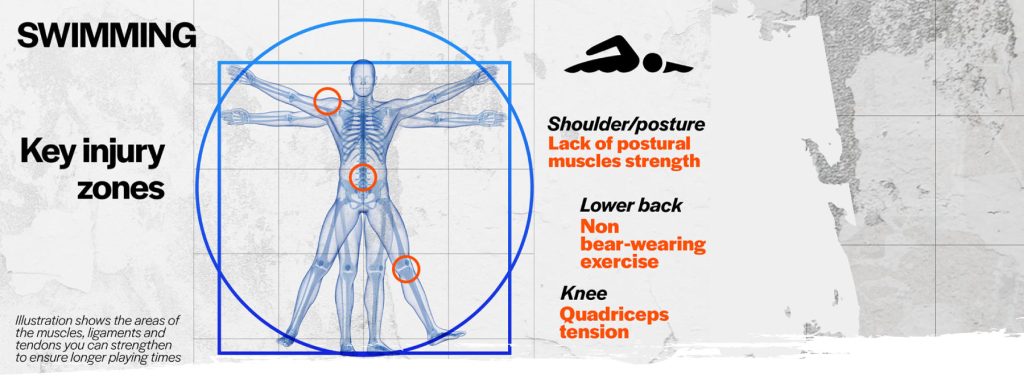Swimming is a phenomenal all-rounded activity which helps you develop stamina, strength and agility.
It is a tough endeavour for your metabolism: cooling down is a nightmare, as sweat doesn’t work in water; warming up requires a huge amount of energy if the water is really cold. Plus, water creates a lot more resistance than air. Propelling through it is not exactly what our body is designed for. In fact, swimming is one of the highest sports rated by calories consumption among amateurs* and professionals as well, with peaks of daily caloric expenditure of around 5500 cal/day.**
Swimming is sometimes a matter of survival, and it’s a pretty safe sport to choose***. No contact with your opponents and no gravity pulling you down (to a certain extent) protect you from sudden, uncontrolled external forces (no trauma). Swimmers’ enemies are overuse and bad technique.
Let’s dive into the science of injury prevention for swimming!
Shoulder/Posture
The shoulder is hit the worst. Competitive swimmers tend to do very little exercise outside the water, and the results is the “swimming posture”, which produces upper body imbalances, such as a tight chest, forward deltoids and neck and hunched back (kyphosis). This increases your chances of shoulder strain in a big way, it reduces performance and also the length of your swimming career****. Why does this happen? Swimming develops strong chest, shoulders and back muscles, but since you don’t support your bodyweight in water, the deeper postural muscles become atrophic (small and weak). So the big muscles pull your bones in the wrong directions, without the control of the smaller ones.
Michael Phelps’ posture below …
Lower back
Lower back problems arise from the lack of continuous forces acting on the area****. You could ask: isn’t that a good thing? The less stress the better? Unfortunately not. We evolved to walk, stand and lie down on land, under the constant effect of gravity. Hips and lower back is pretty much where all the strongest forces are discharged during movement. But, if your activity is only (or predominantly) swimming, there are no significant downward forces acting on your spine, weakening bones, cartilage and muscles. So anytime you undertake anything that DOES involve those forces, your body won’t be prepared for it. Whether those activities are water related (e.g. diving) or not, you’re nevertheless going to have a sore back and therefore underperform.
Knee
Knee is another common injury, slightly dependant on stroke*****. Overuse seems to be the main cause. Think about how many flutter kicks and whip kicks you make every session. This creates an overload on your kneecaps (patellae) due to the constant tension of your quadriceps. The worst movement seems to be the breaststroke kick, which aggravates what already mentioned with an extreme hip extra-rotation (abduction).
EXERCISES
OK! What can we do on dry land to help prevent all of this?
Reinforce and mobilise your upper body:
T, Y, I shapes
Lie on the ground facing down. Form a T shape with your arms and raise them slowly up and down. Close the angle, forming a Y shape. Lastly, arms up (keep elbows straight!) and raise them in a I shape. Don’t worry, it will be really hard and the range of motion will be minimal. Also, make sure your belly stays solid, so that nothing moves except your arms! Repeat each of the three movements 10 times, 30 in total.

Pike hold
Put your feet on an elevated surface (box, step, chair) making sure it’s safe and stable. Hands on the floor in front of it, and with your legs as straight as you can (no worries if there is some bending), push your hips forward until they are directly above your hands. Hold for as long as you can, but remember to save some energy for a safe descent! Repeat 3 times.

Thoracic mobility
Lie on your side with your knee pulled up at around 90 degrees and the other leg straight. The arm on the ground is straight in front and the other one opens and closes, but your knee stays on the floor. It will be hard to move your arm the full 180 degrees, but it doesn’t matter: the stretch consists in trying as hard as you can!

Strengthen your lower back:
Squat jumps
All the jumps will make your back extremely strong! More important than to jump high, is to jumpWELL! To ensure the maximum involvement of your lower back, put your arms behind your neck (don’t pull too much) and keep your elbows as far back as you can. Then do a squat and from the lowest position you can reach, jump up nice and straight, landing down into the next squat. Repeat 10 times for 4 sets.

Back extensions
Lying on your belly, once again position your hands behind your neck and retreat your elbows as far behind as you can. From there, try to lift your chest up away from the ground and slowly bringing it down. Repeat 10 times for 4 sets.

Fortify your hamstrings
Single leg deadlifts
Find a couple of little weights (two water bottles will be perfect). Then balance on one leg, which you will keep slightly bent. Extend the other one straight out. Keeping your back perfectly flat, bend over and try to reach your foot with the bottles. It is important to remember that you only need to bend over as far as you can keep your back straight. Repeat 12 times each leg for 4 sets.

References:
*Harvard EDU: Diet and Weight loss. Available from: https://www.health.harvard.edu/diet-and-weight-loss/calories-burned-in-30-minutes-of-leisure-and-routine-activities [27/12/2020].
**Hirouki S., Kosuke M., Makiko T., Jun Y., Hiroaki T., Yasuki H. (2018) ‘Total energy expenditure in elite open-water swimmers.’ Journal of applied physiology, nutrition and metabolism.
***Kerr Z. Y., Baugh C. M., Hibberd E. E., Snook E. M., Hayden R., Dompier T. P. (2015) ‘Epidemiology of national collegiate athletic association men’s and women’s swimming and diving injuries from 2009/10 to 2013/14.’ British Journal of sports medicine, 49(7), 465-471.
****Ackland, R. T., Elliott, C. B., Bloomfield, J. (2009) Applied anatomy and biomechanics in sport. Champaign: Human Kinetics
*****Wanivenhaus, F., Fox A. J. S., Chaudhury S., Rodeo, S. A. (2012) ‘Epidemiology of injuries and prevention strategies in competitive swimmers.’ Journal of Sports Health, 4(3), 246-251.
Further reading
Encyclopaedia Britannica: Swimming. Available from: https://www.britannica.com/sports/swimming-sport [27/12/2020].






